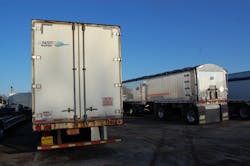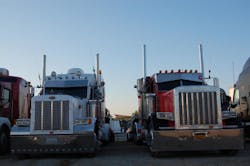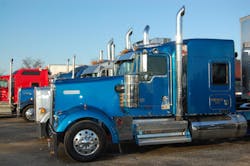On the outside it seems a contradictory proposition: using data to match the “perfect” shipment to the “perfect” truck allows shippers to cut costs while increasing profits for motor carriers. Yet that is the theory behind “smart capacity” that is driving the technological underpinnings of the “Uber for Freight” movement.
“Rarely is there a perfect match between a shipment and a truck,” Abtin Hamidi, co-founder of Cargo Chief, explained to Fleet Owner. “There’s always a compromise of some sort that can result in deadheading or service failures.”
The key for trucking companies – especially small to medium-sized carriers – is to keep assets moving with steady, predictable freight.
But finding such freight boils down to detailed data analysis, Hamidi stressed: using seasonal, regional, and other precise shipment data to identify “hot markets” for freight demand, then finding loads that will help motor carriers reposition their trucks into those markets ahead of that demand.
He calls that a “backward ripple effect” and it relies on creating what Hamidi dubbed a “new level of visibility” through “machine learning” so it can eventually be done automatically – thus creating “smart capacity” that’s more highly attuned to the ebbs and flows of the freight market.
That might sound far-fetched to some fleets, but Steve Sashihara, the founder and CEO of Princeton Consultants, thinks that very philosophy is going to be a major “digital disruptor” within the freight transportation industry over the next eight years.
“I think that the exciting thing that Uber’s done is gotten people in our industry is inspire them when they have been fairly slow to adopt technology; it’s now gotten a lot of us thinking a lot more like an entrepreneur,” he explained in a recent conference call hosted by Stifel Financial Corp.“Some of the tailwinds that are supporting radical disintermediation of freight transportation are that drivers, equipment, storage, are all considered commodities and new ways [are being developed] to match spare capacity. And [dealing with] the surge in seasonal demand is compelling both to buyers and to sellers. So that’s a market waiting to happen.”
Sashihara believes there will be “three primary use cases” for this “smart capacity” model going forward.
“One is that increasingly Amazon and others are getting people to become addicted to same day/next day delivery, so the ability to match a little bit of extra capacity with a little bit of extra maybe unforeseen demand, particularly with LTL, might make some sense for some businesses,” he said. “Call that ‘the Uber if you will.”
Second, Sashihara emphasizes that this “Uberization” of freight won’t replace brokers and other “middle men” in the freight market.
“We think, in fact, it makes the whole intermediary area a lot more efficient and gives them more tools to work with,” he pointed out. “Literally some of our clients are still faxing, but their main information chain is still the phone and e-mail [while] EDI [electronic data interchange] systems are slow and painful. [That’s why] we think that this is really going to allow the intermediaries – whether a 3PL [third party logistics company] or a broker to keep everything in coordination.”
Finally, Sashihara thinks the rapid growth of “Uber for Freight” offerings is going to force more folks within the freight transport world “to think deeply about how to replace aging EDI specifications and all this highly manual work” being done today.“One of my friends runs a small drayage company … and he showed me that one of his dispatchers had 20 tabs open on their web browser, each tab for a different customer or vendor portal that they had to log into and either say, ‘Tell me what’s up with my freight’ or ‘Here’s where my driver is.’”
Sashihara’s point is asking why shippers and carriers alike need to dig through such systems to make simple freight connections: “Why shouldn’t there just be an app that everyone uses that we can track our own freight or comments?”
That to him is the “conversation” Uber is fostering in the freight world. “I think the Uber for freight transportation is less about taking out the middle guy … but more about looking at the business model that the Uber company has turned on its head – the taxi cab industry – and saying, ‘How can we take some of those lessons on for here?’”
John Larkin, Stifel’s managing director and head of transportation capital markets research, believes such “conversations” will force the industry to think about how technology is going to change the landscape in the freight transportation universe.
“Suffice it to say that, freight transportation companies have not been at the cutting edge of technology historically,” he emphasized. “They’re typically late adopters.”
Yet Cargo Chief’s Hamidi is confident that taking the technological steps to create “smart capacity” will result in better results for all involved.
“Getting more details about specific lanes can help shippers lower cost; for example changing the days of their shipment so they can get a better price,” he said.
Yet such moves then allow carriers to attain more loaded miles, pushing up overall revenues and profits. “Creating the ability to make more detail connections is what will drive this,” Hamidi noted.
About the Author
Sean Kilcarr
Editor in Chief
Sean Kilcarr is a former longtime FleetOwner senior editor who wrote for the publication from 2000 to 2018. He served as editor-in-chief from 2017 to 2018.


